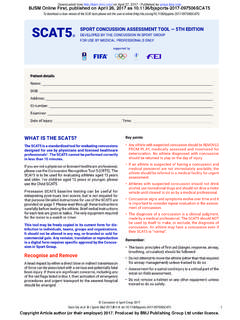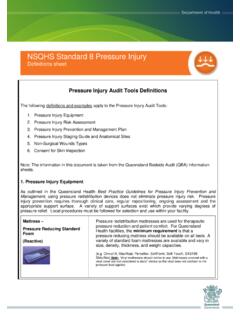Transcription of An overview of dyscalculia - ed
1 Amt 63 (3) 200717 Matthew Thomas MichaelsonQueensland University of many children, mathematics is an inherently difficult subject tolearn. Between 5 and 8 percent of children between the ages of 6 and14 have a particular type of cognitive deficiency that limits their aptitude toacquire knowledge and understanding of fundamental ideas in numeracy(Geary, 2004). Increasingly, researchers in the cognitive sciences arestudying this deficiency under the name dyscalculia , a disorder in whichnormally intelligent children demonstrate specific disabilities in learningmathematics (Ansari & Karmiloff-Smith, 2002). Teachers need to beinformed about dyscalculia so that they can implement strategies thatintentionally and explicitly accommodate students who have this objectives of this paper, therefore, are to define dyscalculia , to considerthe origins of dyscalculia in psychological, biological, and pedagogicalcontexts, to describe the criteria required to diagnose students with dyscal-culia, and to delineate practical methods and instructional designs that canbe implemented in the classroom to address the specific learning needs ofdyscalculic is dyscalculia ?
2 In the most general sense, dyscalculia is the inability to obtain a suitable andappropriate competence in mathematics (Butterworth, 2003) and theinability to build mathematical relationships successfully (Beachman &Trott, 2005). Although an etiological understanding of dyscalculia is stillundetermined, numerous studies have attempted to find some possiblecauses. One hypothesis, which claims that dyscalculia is hereditary, isgaining support in the cognitive sciences (Ansari & Karmiloff-Smith, 2002),because the mathematical learning disorder is unusually common in iden-tical twins and, to a lesser degree, fraternal twins and other siblings(Alarcon, Defries, Gillis Light & Pennington, 1997; Shalev, Manor, Kerem,Ayali, Badichi, Friedlander & Gross-Tsur, 2001). Other research has beenless successful in formulating whether there is a biological malady within thebrain that specifically causes dyscalculia (Dehaene, Spelke, Pinel, Stanescu& Tsivkin, 1999; Kiefer & Dehaene, 1997; Levy, Levy & Grafman, 1999;Spelke & Dehaene, 1999).
3 Although emotional problems caused by environ-mental deprivation are generally regarded as secondary complications forAn overview of dyscalculiaMethods for ascertaining and accommodatingdyscalculic children in the classroomamt 63 (3) 200718other learning disorders (Broman, Bien & Shaughnessy, 1985), their effectson the development, sustainability, and treatment of dyscalculia haverecently gained reconsideration as a potential primary cause (Shalev &Gross-Tsur, 2001). One team of educational psychologists believes thatoverall low intelligence contributes to a person s acquisition of dyscalculia (Miller & Mercer, 1997). Another researcher thinks that mathematics anxietyplays a role in the development of symptoms of innumeracy even whenpsychological intervention can provide a certain degree of remediation(Ashcraft, 1995). At least two publications suggest that ineffective teachingstrategies, particularly in the years of early childhood, might promote thedevelopment of a mathematical learning disability in vulnerable students(Butterworth, 2003; Shalev & Gross-Tsur, 2001).
4 One last proposition is thatpoor social skills might contribute to the progression of dyscalculia (Rourke,1989). In all likelihood, different components of mathematical cognition areinfluenced by a myriad of causes (Geary, 2004) making it impossible to iden-tify just one that is responsible for the whole of origins of dyscalculiaEven though the cognitive sciences have not yet been able to establish athorough understanding of the origins of dyscalculia , there have beenseveral discoveries that have helped to develop some important correlationsbetween dyscalculia and other learning and psychological disorders. Manystudies have shown that a considerable number of dyscalculic childrensuffer concurrently from additional ascertained difficulties. For example,one analysis discovered that approximately 17 percent of dyscalculic chil-dren are also dyslexic, and another 26 percent experience the effects ofattention deficit hyperactivity disorder (Shalev, Manor, & Gross-Tsur, 1997).
5 Two years later, a paper suggested that 4 in 10 people who are diagnosedwith dyslexia also have trouble with mathematics to some measurableextent (Butterworth, 1999). Therefore, an independent diagnosis of dyscal-culia is often difficult to ascertain (Gross-Tsur & Manor, 1996; Ostad,1998). Nevertheless, there are some methods that educational psychologistsutilise to detect dyscalculia in a for diagnosing dyscalculiaCurrently, there are three well-documented methods for diagnosing dyscal-culia. The following sections describe each of the three methods in s attainment of age-appropriate mathematical skillsThe first method for determining whether or not a child is likely to havedyscalculia can be implemented easily in schools using existing studentdata and resources. Through the administration of a standardised assess-ment designed to measure the child s attainment of age-appropriatemathematical skills (Shalev & Gross-Tsur, 2001), educators might be ableto form a diagnosis of dyscalculia if at least one of the following two circum-stances is revealed: an inconsistency between the intellectual capability of the child and theresults of the assessment (Geary, 2004; Reynolds, 1984); or, a significant disparity, usually of at least two year levels, between theamt 63 (3) 200719child s ordinal year of study and his or her arithmetic aptitude (Semrud-Clikeman, Biederman, Sprich-Buckminster, Krifcher-Lehman, Faraone,& Norman, 1992).
6 However, both circumstances are too general to assess accurately thespecific extent to which a child may have dyscalculia . Therefore, somestudents might be incorrectly ascertained as dyscalculic when they mightactually be affected by other more predominant learning observation of dyscalculic tendenciesAnother way to detect the signs of dyscalculia involves the direct observa-tion of a majority of the following behaviours: undeveloped strategies for problem solving (Geary, 1990); computational errors caused by a poor working memory span (Siegel &Ryan, 1989); deficiencies in the long-term recall of arithmetic facts (Geary, Hamson, &Hoard, 2000; Jordan & Montani, 1997); slow rate of processing of basic mathematical skills (Geary & Brown,1991); inability to recognise the commutativity of addition and multiplication(Kaufmann, Handl, & Thony, 2003); high rates of errors, particularly those that appear careless (Geary,1993).
7 And, troubles with visual and spatial functioning (Rourke & Finlayson, 1978).However, any student who is struggling with mathematics wouldroutinely demonstrate one or more of these performance indicators. Justlike the assessment of a child s attainment of age-appropriate mathematicalskills, this method may incorrectly assess non-dyscalculic children asdyscalculic. Therefore, a comprehensive and unambiguous approach isneeded to correctly identify dyscalculia in students so that instructionaldesigns can be modified to accommodate them in the dyscalculia ScreenerOne solution could be the dyscalculia Screener developed by Butterworth(2003). The dyscalculia Screener consists of a series of item-timed teststhat quickly and reliably identify dyscalculia without influences from otherpotential causes of an inadequate achievement in numeracy.
8 Its primaryobjective is to measure the instinctive numerical proficiency of childrenbetween the ages of 6 and 14. Because human beings possess a biologicalinclination to gain a foundation level of understanding of numericalconcepts, certain basic mathematical skills develop naturally withoutformalised education (Ginsburg, 1997). For example, a person can concep-tualise size (that six is bigger than five), number (that a set of objects has anumerical value), and counting (that four comes after three). TheDyscalculia Screener, therefore, is designed to measure a child s level ofinherent numeracy through simple tests involving counting dots andcomparing numbers. Because the essential aspect of the tests is the speedwith which the subject responds to the questions, Butterworth (2003) devel-oped the dyscalculia Screener as a software program to administer thetesting procedure.
9 The programs will also collate the subject s responses,automatically analyse the aggregated results, and finally calculate a stan-dardised score . This score correlates median reaction time with correctnessof responses to generate composite scores in each of the three categories:amt 63 (3) 200720(1) dot enumeration; (2) number comparison; and, (3) arithmetic achieve-ment (age-appropriate addition and multiplication). Table 1 summarises thethree diagnoses that can be ascertained given the combination of qualita-tive scores in each category:DiagnosisDotEnumerationNumberCo mparisonArithmeticAchievementHas poor arithmetic skills but does not have dyscalculiaHighHighLowHas dyscalculiaLowLowMediumPerforms normallyHighHighHighTable 1. How results from the dyscalculia Screener tests lead to a diagnosis of , a child who has dyscalculia will perform at a low level in thedot enumeration and number comparison tests but at a medium level in thearithmetic achievement test.
10 On the other hand, a child who has poor arith-metic skills but does not have dyscalculia will perform at a high level on thedot enumeration and number comparison tests but give a low level perfor-mance in the arithmetic achievement test. Different degrees of diagnoses ofdyscalculia can be interpolated based on the actual stanine the dyscalculia Screener is likely to be the best tool availablefor identifying dyscalculia in children, some schools may be discouragedfrom using it because of financial and social reasons. According to onevendor, the price for one school site license of the dyscalculia Screener isUS$ (A$ ) plus annual renewals of US$ (A$ , at thetime of writing) (Felix, 2005). For many schools, especially those which relyexclusively on public funding, the cost of the dyscalculia Screener maysimply exceed budget limitations. Other schools, on the other hand, may beinfluenced by the societal disposition that mathematical learning difficultiesare normal (Vaidya, 2004).












